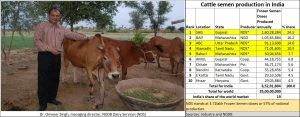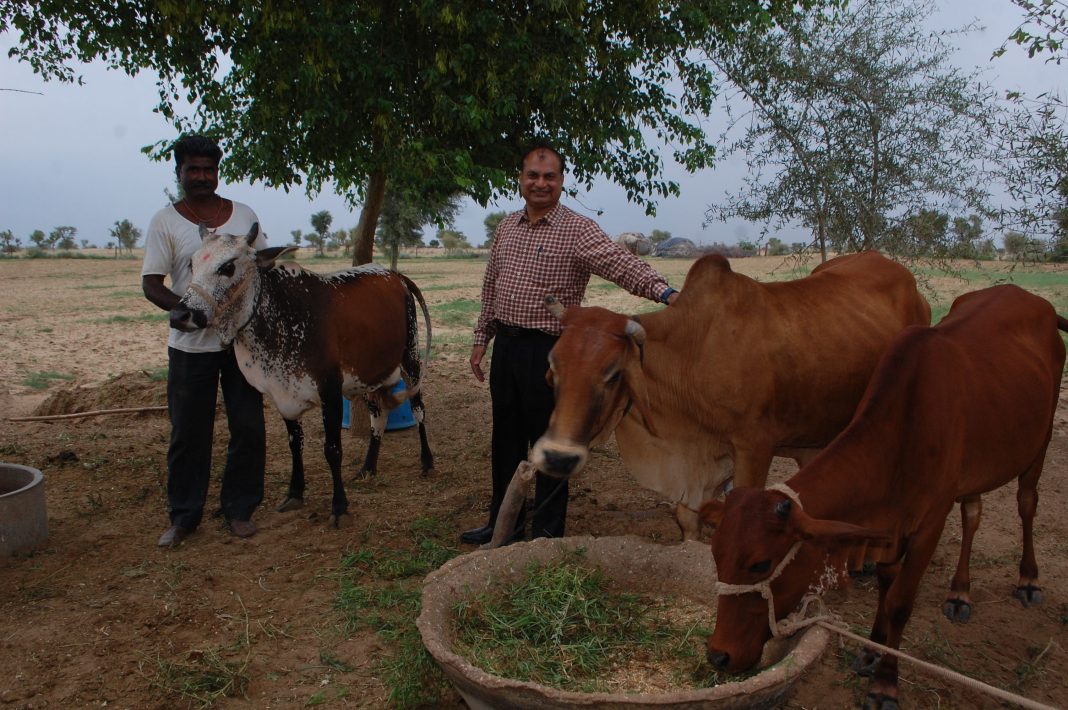https://www.freepressjournal.in/analysis/cattle-semen-is-a-big-business-indeed
India becomes a major player in the cattle semen business
RN Bhaskar — September 25, 2019
Ask Dr. Omveer Singh, managing director of NDDB Dairy Services, and he will tell you that cattle semen production is increasingly becoming a very important strategic industry in India. It is synergistic with the Operation Flood movement that Dr. Verghese Kurien started in the country which made India the world’s largest milk producer.
 Even so, the constant complaint has been that the productivity of cattle in India is pathetically low. That left India with two options:
Even so, the constant complaint has been that the productivity of cattle in India is pathetically low. That left India with two options:
One was to allow farms to import high yielding cattle varieties (particularly Holstein and Friesian) and mate them with Indian cows. But that would have been a slow, expensive and even risky proposition. This is because every imported animal comes from a different ecosystem. In brings into another geographical area not only its capability of producing more milk, but its own biological defence mechanism as well, meant for its home environment. Change the territory, and it could become vulnerable to diseases peculiar to the new environment, and even introduce vulnerabilities that Indian cattle may not be able to cope with.
That is why governments across the world forbid import of animals and other creatures from another territory without first subjecting them to quarantines and rigorous checks. And since such cross-breeding is sought to be done at the farm level, it can turn out to be expensive as well.
That is where the second option of promoting cattle semen production centres becomes significant. These centres produce large quantities of semen that go through all the processes for weeding out disease-prone strains, and combining the qualities of high milk production with high disease resistance as well. The process involves tremendous research, employment of skilled personnel and also constant monitoring of thousands of cattle through generations to capture any biological quirks that might have escaped attention within the laboratories and production centres. This semen is made available to farmers, who — using experts in artificial insemination (AI) — impregnate their milch cattle for producing higher yielding, yet disease resistant, offspring.
Since the work involved is highly skilled and capital intensive, it is not surprising that nine of the top 10 cattle semen production centres in India are run by governments and cooperatives.. The largest, of course are managed by NDDB’s own offspring, NDS (see table). The sole exception is Chitale, which is a well-known brand in and around Pune in Maharashtra. For this family, the main business is semen production, and milk is thus a by-product which the Chitale family procures from its farmer-customers to get constant input on the biometrics of the crossbred offspring.
Thanks to AI — using semen which combines high output with disease resistance to local ailments — small farmers are “are better able to withstand distress due to extreme weather conditions”, says Omveer Singh, managing director, NDS. His key concern is “to conserve and improve the productivity of Indian indigenous breeds”. His aim is to work towards 100 per cent AI along with advanced cutting-edge reproductive technology.
Singh points to how India has been blessed with a huge biodiversity of 43 indigenous cattle breeds and 13 buffalo breeds. These species have survived over last hundreds of years and have thus developed immunity to local conditions and pests. The cattle semen stations try cross-breed these species with cattle that produce larger quantities of milk, without allowing the immunity factor to come down significantly.
Thanks to high quality AI, and domestic demand, India has seen a growth in milk production even as the population of cattle has declined. The 18th cattle census in India reported the existence of some 199 million cattle. The subsequent census (in 2012) saw this population decline to 191 million. But milk production increased in India from 122 million tonnes in 2010 to 146 million tonnes in 2014 and then to 176 million in 2018. At the same time, even though India’s share of world cattle population is only13% (http://dahd.nic.in/about-us/divisions/cattle-and-dairy-development), its share of cattle semen production has swelled to 18% in the world.
Clearly, cattle semen production has been growing at a healthy pace. From just around 13 million doses of cattle sperm in 1995, it swelled to 65.3 million last year. Lately India has also begun exporting cattle sperm – countries like Brazil are favourably inclined towards Indian strains of cattle. It won’t be long before India begins catering to developing countries in Africa and South East Asia as well.
As Omveer Singh says, the potential for this industry is huge. The rewards are just becoming visible.






































COMMENTS